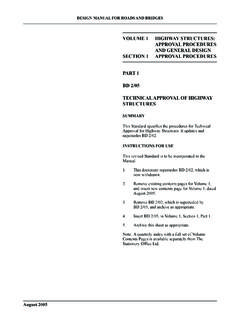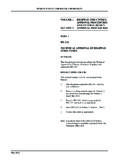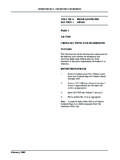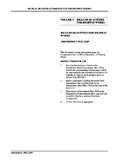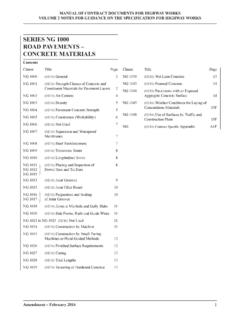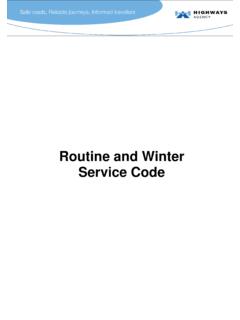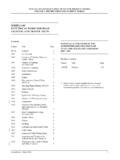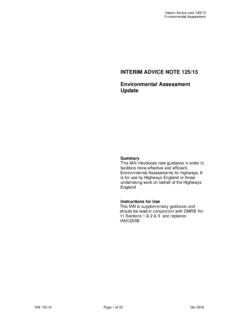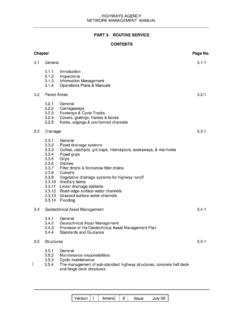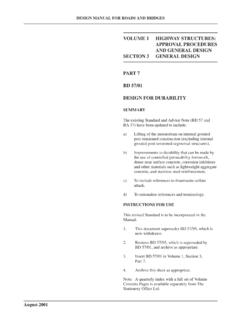Transcription of DMRB VOLUME 1 SECTION 3 PART 5 - BD 60/04 - THE …
1 May 2004 DESIGN MANUAL FOR ROADS AND BRIDGESVOLUME 1 HIGHWAY STRUCTURES:APPROVAL PROCEDURESAND GENERAL DESIGNSECTION 3 GENERAL DESIGNPART 5BD 60/04 THE DESIGN OF HIGHWAY BRIDGESFOR VEHICLE COLLISION LOADSSUMMARYThis Standard gives criteria for the design of highwaybridges for vehicle collision loads. It updates andreplaces in part BD 37 FOR USEThis is a new document to be incorporated into Contents pages for VOLUME new Contents pages for VOLUME 1, datedMay BD 60/04 into VOLUME 1, SECTION 3, part archive this sheet as : A quarterly index with a full set of VolumeContents Pages is available separately from TheStationery Office Ltd.
2 BD 60/04 The Design of Highway Bridgesfor Vehicle Collision LoadsSummary:This Standard gives criteria for the design of highway bridges for vehiclecollision loads. It updates and replaces in part BD 37 MANUAL FOR ROADS AND BRIDGESTHE HIGHWAYS AGENCYSCOTTISH EXECUTIVEWELSH ASSEMBLY GOVERNMENTLLYWODRAETH CYNULLIAD CYMRUTHE DEPARTMENT FOR REGIONAL DEVELOPMENTNORTHERN IRELANDV olume 1 SECTION 3 part 5 BD 60/04 May 2004 REGISTRATION OF AMENDMENTSA mendPage NoSignature & Date ofAmendPage NoSignature & Date ofNoincorporation ofNoincorporation ofamendmentsamendmentsRegistration of AmendmentsVolume 1 SECTION 3 part 5 BD 60/04 May 2004 REGISTRATION OF AMENDMENTSA mendPage
3 NoSignature & Date ofAmendPage NoSignature & Date ofNoincorporation ofNoincorporation ofamendmentsamendmentsRegistration of AmendmentsVOLUME 1 HIGHWAY STRUCTURES:APPROVAL PROCEDURESAND GENERAL DESIGNSECTION 3 GENERAL DESIGNPART 5BD 60/04 THE DESIGN OF HIGHWAY BRIDGESFOR VEHICLE COLLISION A:HGV/Bridge Collision StatisticsAppendix B:HGV/Bridge Collision PhotographsAppendix C:Guidance for Steel and Steel/CompositeBridge DecksDESIGN MANUAL FOR ROADS AND BRIDGESMay 2004 VOLUME 1 SECTION 3 part 5 BD 60/04 May 20041/1 Chapter 1 Introduction1.
4 Collisions of heavy goods vehicleswith the supports and superstructures of highwaybridges occur quite frequently on a national gathered from such accidents (see AppendixA) show that collisions take place with bridge decks ofstandard (or greater) headroom clearance and on roadsof most categories. Although, so far, only one trunkroad bridge has been completely dislodged by acollision, several footbridges and sign/signal gantrieshave been partly or totally removed from their supportsand hence the potential is there for a major catastropheunless appropriate action is taken both for existingbridges and in respect of future bridges.
5 Appendix Bshows photographs of some collisions with Department of Transport set up a workingparty to examine ways of protecting existing bridgesfrom large goods vehicle collisions. The working party,which originally concentrated on railway over-bridgestrikes, considered highway bridges. Variouspreventative measures were considered, some of whichwere implemented. The Highways Agency also assessedand strengthened bridge supports that were consideredto be particularly at risk with respect to collision loads;the requirements are contained in BD 48(DMRB ).
6 Purpose of this Standard is to promulgate thecollision loading requirements for new highway bridgesand foot/cycle track bridges, as a revision of AppendixA Clauses and of BD 37/01 (DMRB ), whichit supersedes [except for the design of certain foot/cycletrack bridge supports (see )]. For bridges other thanhighway or foot/cycle track bridges, such as railbridges, over a highway, the application of thisStandard shall be agreed with the appropriate revised loading represents, more realistically, thepossible effects of heavy goods vehicle collisions and isconsistent with other national and internationalrequirements.
7 This Standard contains the loading, broadprinciples for its application and some specificguidelines for Gantries and Lighting Standard does not cover the design of sign/signal gantries, lighting columns or lightweight maststructures such as CCTV Standard does not cover the design ofgeotechnical structures, such as corrugated steel buriedstructures or reinforced soil Standard should be used forthwith for allschemes currently being prepared provided that, in theopinion of the Overseeing Organisation, this would notresult in significant additional expense or delayprogress.
8 Design Organisations should confirm itsapplication to particular schemes with the licensing purposes an HGV (Heavy GoodsVehicle) has been recently renamed as an LGV (LargeGoods Vehicle). The term HGV is used throughout 1 SECTION 3 part 5 BD 60/04 May 20042/1 Chapter 2 The Requirements2. THE REQUIREMENTSV ehicle Collision Loads on Highway and Foot/CycleTrack Bridge Supports and collision loads on supports andsuperstructures shall be considered for the design ofbridges as secondary live loads, as defined in BD 37(DMRB ), and shall be applied in Load Combination4, also described therein.
9 No other live load shall beconsidered as bridges over carriageways have supportsof which any part is located less than from theedge of a carriageway (see BD 37 (DMRB ) fordefinition) these shall be designed to withstand thevehicle collision loads given in Table 3. Where bridgesupports are located equal to or greater than fromthe edge of carriageway, the Designer is required toanalyse the vulnerability of the supports to vehicularimpact. The Designers should use engineeringjudgement and risk assessment techniques to ascertainthe level of risk and vulnerability.
10 Where theassessments indicate that the potential risk of vehicularimpact is severe, the supports shall be designed to thosecollision loads given in Table 3 or appropriateadditional mitigation measures, eg safety barriers, shallbe provided. The Designer s choice of action in thisrespect and the design collision loads shall be recordedas appropriate eg in AIP in accordance with BD 2(DMRB ). As a general guidance, it is intended thatthe definition of above-mentioned severe potential riskof vehicular impact would only apply to special casessuch as footbridges with single column support, majorlong span bridges etc.

